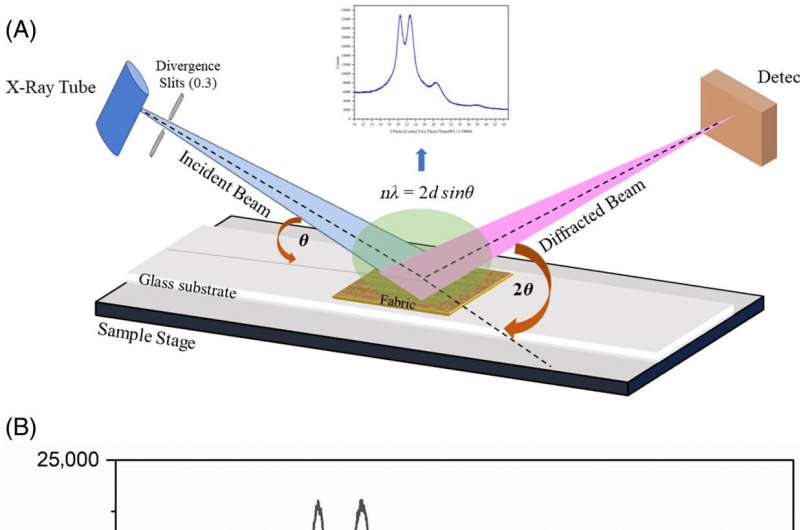This article has been reviewed according to Science X's editorial process and policies. Editors have highlighted the following attributes while ensuring the content's credibility:
fact-checked
trusted source
proofread
Research comes to the rescue to make firefighters' clothing safer

A pair of new University of Alberta studies show how to make firefighters' clothing safer to wear, maintain and manufacture.
One study revealed that some fibers used in the protective gear break down when exposed to warm water, showing what can happen to the garments over time, during real-life firefighting scenarios and laundering.
The other study analyzed the water used in the manufacture of fibers, identifying a handful of harmful dye compounds leaching from the fabrics that could weaken their protective qualities.
"The findings of both studies show vulnerabilities and potential ways to improve the materials currently being used in firefighters' clothing, and for maintenance," says Saiful Hoque, who conducted the work to earn a Ph.D. in textile and apparel science from the Faculty of Agricultural, Life & Environmental Sciences (ALES).
Wear and care
Using accelerated aging treatments reflecting firefighting and laundering conditions, the first study, published in the Journal of Polymer Science, investigated the effects of heat and water on 15 different yarns in eight fabrics typically used to manufacture protective clothing.
The fibers were immersed in both purified neutral pH and acidic water ranging from 40°C to 90°C for up to 1,200 hours at a time, then checked for physical, chemical and other types of deterioration.
The results of the hydrothermal aging showed that fabric blends containing a particular type of fiber, called para-aramid/polybenzimidazole, or PBI, degraded in strength 68% more quickly when exposed to moisture, as opposed to similar fire-protective fabrics that didn't contain PBI.
High-performance fiber blends containing PBI are typically used to make firefighters' outer jackets and trousers, due to the fiber's flexibility and ability to withstand extreme temperatures.
But because PBI fibers are manufactured using sulfuric acid, traces of the chemical remain behind, shows a 2022 study led by Hoque. That residual sulfur increases a fabric's sensitivity to moisture, and could lead to premature degradation of protective garments, Hoque notes.
The findings can help manufacturers of high-performance fibers and protective fabrics improve their processes, he suggests.

"PBI fibers are still good to use, but it's critical that producers develop ways to remove the residual sulfur from those fibers."
Laundering of firefighting gear also needs to be changed up, by washing clothing with PBI fibers separately, Hoque advises. "This prevents the risk of damage to neighboring fabrics that don't contain PBI fibers and wouldn't otherwise experience degradation in warm water."
The same study also established, for the first time, that meta-aramid fibers, another type commonly used in protective clothing, showed "remarkable resistance" to heat and water stress, even when exposed to acidic water, Hoque says.
For example, one fabric sample comprising 93% meta-aramid fibers lost only 4% of its tensile strength after being immersed in water for 1,200 hours at 90°C.
That discovery fills a knowledge gap about the effectiveness of high-performance fibers to resist heat and water, allowing manufacturers "more informed decisions in the selection and design of materials for more durable gear for firefighters," Hoque says.
It also opens up possibilities for using meta-aramid fibers in other products frequently exposed to water, such as marine safety equipment, he adds.
The overall exploration of the various yarns and their fibers provides a fuller understanding of their durability, Hoque says. "We can now offer manufacturers suggestions for optimum fiber blends and fabric configurations that strike a better balance between long-term protection and comfort."
Responsible manufacture
In Hoque's second study, published in Fibers and Polymers, he developed a method of analyzing the water used in the experiments, which can be used by fabric manufacturers to make their production processes more environmentally sustainable, he says.
The analysis identified three dye-related compounds known to pose some risk to the environment, "particularly when they leach into water systems," he notes.
Though not recommended for use, "it's possible that some manufacturers still employ these compounds, so this information can help them prevent environmental pollution and adopt more sustainable practices."
More information: Saiful Hoque et al, Hydrothermal aging behavior of high‐performance polymeric fibers: Mechanical performance at the yarn scale and chemical analysis, Journal of Polymer Science (2024). DOI: 10.1002/pol.20230950
Md. Saiful Hoque et al, Analysis of Hydrothermal Aging Water of Fire-Protective Fabrics Using GC × GC–TOFMS and FID, Fibers and Polymers (2024). DOI: 10.1007/s12221-024-00540-5
Provided by University of Alberta





















